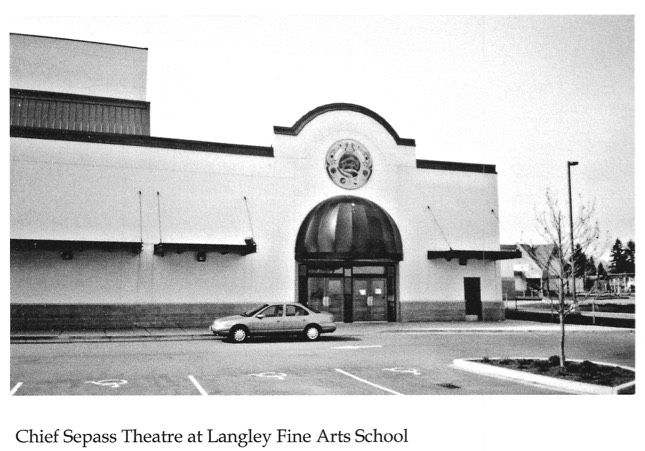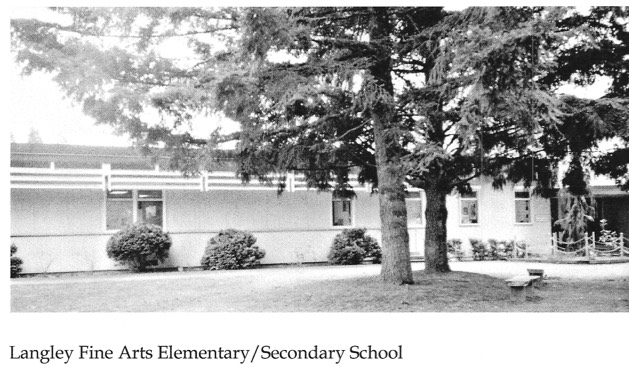
Opened in 1965 at 9096 Trattle Road in Fort Langley, the Fort Langley Junior Secondary served grades 8,9, and 10 from the area around Fort Langley and the northeast section of the municipality. The Fort Langley students were bussed to either Langley Secondary or R. E. Mountain Secondary for grades 11 and 12. The first principal was Roger Winter and the first vice principal was Walt Hennig, both of whom had served at Aldergrove Secondary for many years.
The school is located on 9.56 Acres (3.86 hectares) on a quiet residential street. It is built of wood frame construction, with exterior wood siding and stucco. The original construction meant that every footstep in the halls could be heard in the classrooms—very irritating for teachers and students. There are wood windows with acoustic tile ceilings in the classrooms. It is a one-storey structure with one long hall north and south and a long hall to the east. The school is screened by shrubbery and trees so that it blends with the surrounding neighbourhood.
As the population grew from the original 200 students to its peak of 500 students in 1976, additional rooms were needed. In 1968 a band room, the north wing, and four classrooms were added. In 1972 an art room was built, in 1974 a science wing (northeast) was added, and in 1976 a gym addition and drafting room were built. When Fort Langley Junior became the Langley Fine Arts School, the building underwent an extensive renovation. The Chief Sepass theatre and additional art rooms were added in 1996, and in 1998 seven classrooms were added to the north. The school in 2002 has a newly-renovated office just north of the main entrance, 22 standard classrooms, 3 science rooms, a gym, a library, 3 art rooms, a cafeteria, special education room, 3 band rooms, a computer room, a L.A. room 2 drama rooms, a theatre, 3 dance studios, a video production room, and a career centre/counselling office.
The sewage waste leaves the building on the east side and flows into a large pump chamber. It is then pumped by 2 Myers sewage pumps to a municipal connection at the parking area near the Fort Langley Cemetery. The water supply enters through a two-inch meter located in the boiler room. The school has a galvanized chain link 4-foot perimeter fence. There is a bark-mulch jogging circuit with fitness stations, two tennis courts, an adventure play area for the elementary students, and an intermediate-sized playing field.
There is a bus stop just south of the school on Trattle for those students arriving from some distance. Many students walk to the school or are driven from all over the municipality, now that it has become a fine arts school rather than a strictly neighbourhood school.
Despite its small size as a junior secondary school from 1965 to 1991, the students enjoyed all the program benefits of their counterparts in the larger schools of Langley. The emphasis on academics was balanced by a full range of elective subjects, supported by a strong intramural program. The school's music program also enjoyed some success, particularly in choral jazz. The school also enjoyed many athletic successes in district competition.
Following Roger Winter as principal were Bob McCubbin, Al MacLean, and Richard Bulpitt. Vice principals over the years included Walt Hennig, Dan Peebles, Dave Michel, Burns Maddin, and Frank Roberto.
In 1986, it was decided by the School Board and Superintendent Emery Dosdall to close Fort Langley Jr. Secondary and open the Langley Fine Arts Elementary/Secondary School in the same building. The first principal of the Langley Fine Arts School was Richard Bulpitt, followed by Peter Beckett, who served for seven years. In 1998, Wendy MacKinlay became principal, followed by Percy Pavey as a temporary principal and then Kerri Gregory in the fall of 2001. Vice principals of Langley Fine Arts over the years have included Peter Harrower, Susanna Eppich, Magdy Ghobrial, Dave Michel, Terrie Levitt, Tom Turner, Gail Pridham, and Shawn Davids. The principal in 2004 is Balan Moorthy, and the vice principals are Greig McArthur and Jon Bonnar.

The Langley Fine Arts School was set up to cater to those students wishing to specialize in the fine arts areas of dance, art, music, literary arts, and theatre. Students enrol from all over Langley and nearby municipalities to take advantage of the specialist teachers and extra emphasis on fine arts. These students also take a full academic program and are involved in numerous programs which take place out of school hours. When the school first opened, some grade 12 students had to take senior courses such as Literature 12 at LEC in the evening because of small enrolments. The first graduation at LFAS took place in 1994. Recent increased enrolment in the senior grades has resulted in the Langley Fine Arts students winning 6 district scholarships and 9 provincial scholarships in 2002. The school receives many visitors from other school districts interested in the fine arts school concept.
In 1991 the Fort Langley Reunion was held and hundreds of former students and teachers attended. The group set up a trust fund which annually donates a scholarship to a graduate of either Langley Fine Arts Secondary or Walnut Grove Secondary.
The philosophy of LFAS states that the students, staff, and parents share a common belief in the value of a fine arts education. The program enables students to express themselves creatively through the arts, and to respect and support uniqueness and risk-taking. With the arts as a focus, the school works to create a stimulating and culturally enriched learning environment. The goal at LFAS is to help students develop skills of academic and artistic discipline, critical thinking, and self-confidence. As students learn the values of teamwork, personal cornmitment, and responsibility, they also learn to place a high priority on the achievement of personal and group excellence.
The school in 2004 is a community of 428 secondary, 394 elementary, and 34 international students with many specialist teachers and support staff.
The Fine Arts School works as follows: In grades 1-2, the students study in the four fine arts areas, concentrating a total of 320 minutes per week in the fine arts, 80 minutes in each of the four areas. This results in an accelerated pace of learning in language arts, sciences, social studies, and mathematics. In grades 3-7, the students study all four of the fine arts areas, concentrating a total of 480 minutes per week. In grade 8 the students choose two of the four fine arts areas as their major for 5 hours per week, a total of 10 hours. Academic courses are semestered, with an accelerated pace in 90 total hours of learning per course. In grades 9-10, the students choose one of the four fine arts areas as their major, studying 7 hours per week, with an additional 3 hours per week devoted to their choice of fine arts elective courses. Core academic courses are semestered, 90 hours total. In grades 11-12, the students have an expanded choice, with Literary Arts as the fifth of the possible fine arts majors. They choose one of these five as their graduation major, with 7 hours per week in this major and a minimum of 3 hours per week in an additional fine arts elective course. Almost all academic courses are semestered.
- The Fine Arts Courses include the following components:
- Dance: modern, ballet, jazz, choreography, anatomy, hip-hop, dance explorations, dance company
- Drama: acting, script-writing, directing, stagecraft, video, film, critical analysis, theatre history
- Literary Arts: creative and journalistic writing, critical analysis, editing, layout, graphics, desktop publishing
- Music: instrumental and vocal-chamber music, orchestral, jazz, choral, large ensemble, composition, theory, critical analysis, music history
- Visual Arts: drawing, painting, sculpture, multi-media, ceramics, print-making, anatomy, art history, critical analysis, portfolio presentation.
Navigation Links for History of Langley Schools Section
Click on the following
- Langley Schools - Contents
- Acknowledgements
- Bibliography
- The Langley School District - Folder Contents
- Secondary Schools - Contents
- Elementary Schools
or
Return to LRTA Web Site’s Home Page